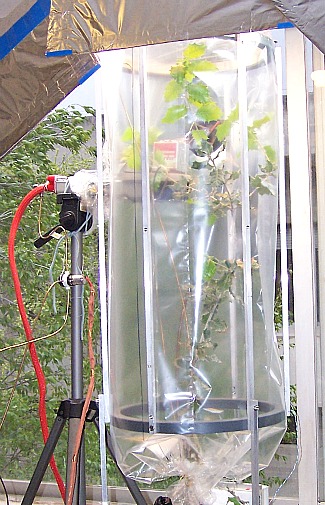Plants warn each other of imminent danger

In their interaction with atmosphere, plants do not only exchange oxygen and carbon dioxide, but also Volatile Organic Compounds (VOCs). VOCs are carbon-based molecules (of usually from one to fifteen atoms of carbon) that evaporate easily at ambient temperature. Besides having multiple roles in plant physiology and ecology, as well as in atmospheric chemistry, several VOCs have been reported as having a communication role between plants and also between plants and animals.
Most part of studies of VOC-mediated communication have dealt with herbivory and priming. In this context, priming refers to the fact that a plant gets ready for the possible attack of a pathogen or an herbivore based on the VOC signals that attacked plants send to the atmosphere, so the primed plant is then able to respond quicker and/or stronger to the herbivore when attacked. Great attention has been focused on certain C6 compounds (aldehydes, alcohols, and their acetates) called green leaf volatiles (GLV). GLV are emitted after mechanical stress and herbivore attack and have shown to be responsible for priming effects on other plants. Other plant-emitted VOCs such as methyl jasmonate (MeJA) and methyl salicylate (MeSA) are also involved in plant defensive metabolism.
Methanol is the smallest (only one atom of Carbon) alcohol and is among a group of short-chain oxygenated VOCs which are becoming more studied in recent years. Under non-perturbed situations, it is released from plants to the atmosphere during leaf growth. Globally, it is the second most abundant organic gas in the atmosphere after methane. But despite being somewhat abundant in the air, it can be emitted by plants in such high amounts during stress episodes –like herbivore attacks and crop harvesting– that it might play a communication role by being detectable as a signal by plants themselves or by other organisms in the near area.
With this experiment we aimed to test whether methanol, a short-chain oxygenated VOC, could also have a signalling role between plants. We monitored photosynthetic performance and VOC exchange rates of holm oak (Quercus ilex L.) saplings before and after two different treatments: a) clipping of some leaves to simulate an attack by herbivores and b) fumigation with gaseous methanol during 5 hours to simulate the amount of methanol a plant could receive from surrounding plants if those had been already attacked by herbivores.
The clipping treatment enhanced the photosynthetic rates, the chlorophyll a to b ratio, and the carotenoid to chlorophyll ratio of non-clipped leaves, suggesting an activation of plant protective metabolism. Also, a small but interesting systemic (in non-clipped leaves) increase in methanol emission rates was observed, which agrees with the possibility that methanol may act as a signalling cue. The methanol fumigation treatment induced an increase in the actual photochemical efficiency of Photosystem II and also in the carotenoid to chlorophyll ratio. Methanol fumigation also promoted a 14% increase in the monoterpene (another type of VOCs) emission rate, one day after the treatment, a similar response to the ones induced by other signalling VOCs.
The enhanced monoterpene emissions could add to the blend of VOCs emitted after stress and be part of further signalling pathways. They may act as deterrents against herbivores, become antioxidants or cell membrane stabilizers, or may act as signals to parasitoids of the herbivores. Hence this terpene signalling role in plant-animal communication, and also in plant-plant communication forwards the message started by methanol. More research is needed to fully understand the roles of each compound in the signalling blend of VOCs. Meanwhile, the results of this study suggest that clipping and methanol fumigation at natural concentrations elicit significant plant physiological responses and further BVOC emissions.
References
"Methanol as a signal triggering isoprenoid emissions and photosynthetic performance in Quercus ilex". Seco R, Filella I, Llusià J, Peñuelas J (2011). Acta Physiologiae Plantarum 33 (6): 2413-2422. DOI: 10.1007/s11738-011-0782-0


